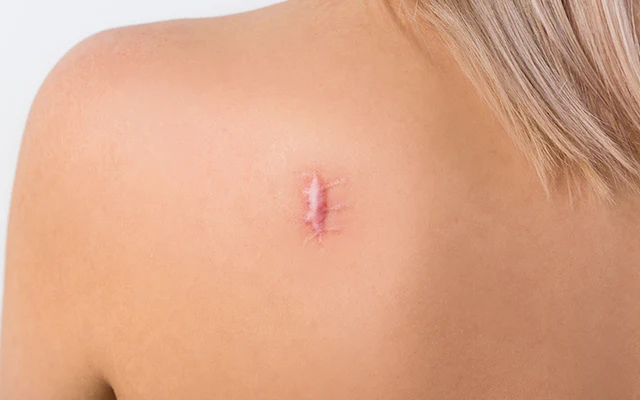Unveiling the Truth About Keloid Scars Meet the Expert: Dr. Marion Elizabeth Fesmire Before we embark on this journey to demystify keloid scars, let’s meet the brilliant mind behind the insights you’re about to discover. Dr. Marion Elizabeth Fesmire, a distinguished dermatologist with over two decades of experience, is our guide. Dr. Fesmire’s extensive research
Unveiling the Truth About Keloid Scars
Meet the Expert: Dr. Marion Elizabeth Fesmire
Before we embark on this journey to demystify keloid scars, let’s meet the brilliant mind behind the insights you’re about to discover.
Dr. Marion Elizabeth Fesmire, a distinguished dermatologist with over two decades of experience, is our guide. Dr. Fesmire’s extensive research and expertise in scar management make her the ideal source for unraveling the secrets of keloid scars.
Now, let’s delve into this comprehensive guide and equip ourselves with knowledge that can transform our lives.
If you’ve ever wondered why some scars don’t just fade away like others, you’re not alone. The world of scars is vast and varied, but today, we’re focusing on a specific type: keloid scars. These stubborn scars can be a source of frustration and self-consciousness for many, but fear not. In this comprehensive guide, we’ll demystify keloid scars, explore their causes, prevention, treatment options, and offer practical advice to help you achieve a scar-free lifestyle.

Image by: https://www.thekeloidplasticsurgerycenter.com/procedure/keloid-scar-removal-surgery/
What Are Keloid Scars?
Key Takeaways:
| Definition | Characteristics | Causes |
|---|---|---|
| Overgrown Scars | Raised, Red, and Firm | Genetics, Injury, Surgery, or Acne |
Keloid scars are not your typical scars. They are characterized by their raised, red, and firm appearance, often extending beyond the original wound area. Unlike ordinary scars that heal over time, keloids can grow and become more prominent.
But what exactly causes these overgrown scars? While the precise mechanism remains a subject of ongoing research, several factors contribute to keloid formation.
Genetics
One of the primary factors is genetics. If you have a family history of keloid scars, you’re more likely to develop them yourself. It appears that certain individuals inherit a genetic predisposition to produce an excessive amount of collagen—the protein responsible for skin’s structure and healing.
Injury
Any injury to the skin can potentially lead to keloid formation. This includes burns, cuts, insect bites, and even acne scars. Keloids often develop at the site of a wound, especially if it’s been subjected to tension or movement during the healing process.
Surgery
While surgery is intended to improve your health, it can sometimes leave behind keloid scars as an unwanted souvenir. Surgical incisions, particularly in areas prone to tension, can trigger keloid formation in susceptible individuals.
Acne
Acne can be a double whammy—first, it can cause unsightly blemishes, and in some cases, it can lead to keloid scarring. This is more common in severe acne cases, where deep cysts and nodules damage the skin’s deeper layers.
Understanding these causes is the first step in addressing keloid scars effectively. If you’re genetically predisposed or have experienced any of these triggering factors, it’s essential to be proactive in your approach to keloid management.
The Emotional Toll
Keloid scars don’t just affect your skin; they can also take a toll on your emotional well-being. The psychological impact of keloid scars should not be underestimated. They can affect your self-esteem, body image, and overall mental health.
People with keloid scars may experience:
Self-Esteem Issues
The noticeable and sometimes disfiguring appearance of keloid scars can lead to self-esteem issues. It’s common for individuals to feel self-conscious or embarrassed about their scars, which can hinder their confidence in social and professional settings.
Anxiety and Depression
Living with keloid scars can be emotionally challenging, leading to anxiety and depression in some cases. The constant worry about how others perceive you and the fear of judgment can take a significant toll on your mental health.
Social Withdrawal
Keloid scars can lead to social withdrawal. Some individuals may avoid social interactions or situations that draw attention to their scars. This withdrawal can lead to feelings of isolation and loneliness.
It’s crucial to recognize the emotional impact of keloid scars and seek support if needed. Speaking with a mental health professional or joining support groups can provide valuable emotional support and coping strategies.
Prevention Is Key
The best way to deal with keloid scars is to prevent them from forming in the first place. Dr. Fesmire shares her expert advice on how to reduce your risk of developing keloids after surgery or injury.
Key Takeaways:
| Preventive Measures | Post-Injury Care |
|---|---|
| Steroid Injections | Silicone Gel Sheets |
| Pressure Dressings | Laser Therapy |
Steroid Injections
One of the most effective preventive measures for keloid scars is the use of steroid injections. These injections, administered by a healthcare professional, help reduce inflammation and prevent excessive collagen production at the wound site. When used promptly after injury or surgery, they can significantly reduce the risk of keloid formation.
Pressure Dressings
Pressure dressings, often made of silicone, can be applied to the healing wound. These dressings apply constant pressure to the scar, flattening it and preventing excessive growth. Pressure dressings are particularly useful for areas where keloid scars commonly occur, such as the chest and shoulders.
Silicone Gel Sheets
Silicone gel sheets are another valuable tool in keloid prevention. They are applied directly to the healing wound and create a protective barrier. Silicone gel sheets help hydrate the scar, reduce redness, and prevent excessive collagen buildup.
Laser Therapy
In some cases, laser therapy can be employed as a preventive measure. Laser treatments can help reduce scar tissue formation and improve the appearance of existing scars. However, it’s essential to consult with a dermatologist to determine if this option is suitable for you.
Effective Treatment Options
If you’re already dealing with keloid scars, fear not! There are several treatment options available, and Dr. Fesmire is here to guide you through them.
Key Takeaways:
| Treatment Options | Pros | Cons |
|---|---|---|
| Surgical Removal | High Success Rate | Risk of Recurrence |
| Cryotherapy | Non-Invasive | Skin Discoloration |
| Radiation Therapy | Effective for Large Scars | Limited Availability |
Surgical Removal
Surgical removal is a common treatment for keloid scars. During this procedure, the keloid is surgically excised, and the wound is closed with sutures. While this method often has a high success rate, there is a risk of recurrence. It’s essential to follow post-operative care instructions diligently to minimize this risk.
Cryotherapy
Cryotherapy involves freezing the keloid scar using liquid nitrogen. This non-invasive procedure can help reduce the size and appearance of the scar. However, it may lead to skin discoloration in some cases.
Radiation Therapy
Radiation therapy is an effective option for large and stubborn keloid scars. It involves the use of targeted radiation to reduce scar tissue. While highly effective, radiation therapy may not be readily available in all locations.
Embrace Your Journey to Scar-Free Skin
In this concluding section, Dr. Fesmire offers words of encouragement and practical tips for embracing your journey to scar-free skin. Remember, keloid scars may be challenging, but with the right knowledge and guidance, you can achieve the confidence and flawless skin you deserve.
Conclusion
Keloid scars no longer need to be a mystery that haunts your skin and self-esteem. Dr. Marion Elizabeth Fesmire has taken you on a journey through the science, emotions, prevention, and treatment of keloids. Armed with this knowledge, you can take control of your skin’s destiny.
Incorporate these insights into your lifestyle, and step into a world where are a thing of the past. Your path to scar-free skin starts here.

















Leave a Comment
Your email address will not be published. Required fields are marked with *